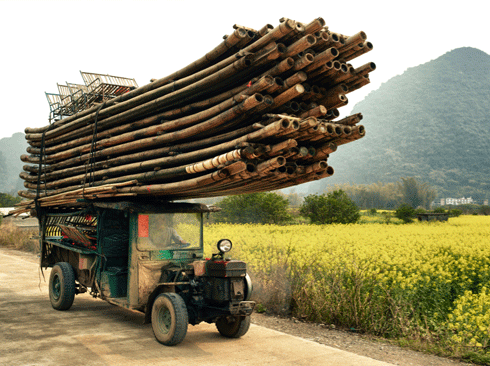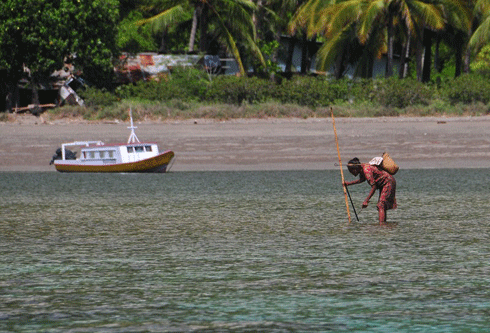
|
Published: 4 February 2013
Unlocking bamboo’s potential to alleviate poverty
Easy to grow, even on steep, marginal land unsuitable for other crops, bamboo has the potential to lift people in rural communities out of poverty – but only with improvements in farmer education and thus crop management, according to a recent project in southwestern China led by an Australian scientist.
An estimated 2 billion people across the globe use bamboo every day to produce everything from household utensils and handicrafts, to scaffolding for construction sites, according to the International Network for Bamboo and Rattan.
Increasingly, though, bamboo also is being recognised for its beauty, durability and flexibility, turning it into a hot, internationally traded commodity, and making it a key resource for livelihood development.
But in some underdeveloped regions of China, that potential is not being reached, despite ideal growing conditions, local access to bamboo stock and a thriving cottage industry.
‘Our research shows that smallholder cultivation of bamboo shoots can make an important contribution to household income and rural livelihoods in impoverished, mountainous regions of China that have limited off-farm income opportunities,’ said Nicholas Hogarth, lead author of a recent Center for International Forestry Research (CIFOR) report.
Hogarth, who is based at Charles Darwin University in Darwin, pointed out that the 12 villages surveyed in the Guangxi autonomous region had little or no knowledge about proven scientific techniques to optimise productivity.
CIFOR researchers collecting quantitative data from 240 households in Guangxi found that forest-based enterprises such as bamboo production often represent the main, or even the only, industry and cash-earning opportunity.
From a sub-family of grasses, bamboo is in many ways an ideal crop for the rural poor. Its clonal growth capacity, rapid growth rates and short rotation cycles enables annual income generation, unlike the long harvest cycle for timber trees.
‘This is a very important attribute given the limited size of most household’s allocated forest land area,’ said Hogarth.
According to the CIFOR report, bamboo also has fewer policy constraints and regulations compared to timber. And, unlike timber, bamboo is relatively light and can be easily harvested and transported without specialised equipment or vehicles.
‘Bamboo production does not require special tools, and there are many skills in bamboo production that are common to agricultural crop management – such as soil cultivation and fertilisation – that are easily adapted,’ Hogarth said.
‘Basic processing and value adding also does not require highly skilled labour or specialised equipment, and can be undertaken by low-income rural communities with minimal capital investment.’
China established large-scale bamboo plantations in the 1950s, and rapidly expanded them in the 1980s following a series of conducive policy reforms around markets, commercialisation, land tenure and forest-use rights. This paved the way for increased smallholder investment in, and management of, plantation forests.
Farmers enthusiastically embraced bamboo as a new cash crop, and planted it and other non-timber forest crops on their allocated household forest land in preference to less-profitable timber species.
According to FAO data, one-fifth of the world’s bamboo now comes from China, which also accounts for more than 600 species (see UN Environmental Programme report Bamboo biodiversity: Information for planning conservation and management in the Asia-Pacific region).
Bamboo has featured in many of China’s poverty alleviation and reforestation initiatives, such as its ‘conservation of cropland forest programme’, in which direct payments are made to households that convert their sloping cropland into forests.
In fact, more than 90 per cent of China’s bamboo appears to be in upland areas, which is where poverty is concentrated, the CIFOR researchers noted, citing World Bank data.
‘A large proportion of households at the study site were living below the poverty line, and in many ways are representative of the persistent low-income people that the central government’s targeted poverty alleviation programs are trying to reach,’ said Hogarth.
In these areas, most farmers’ knowledge about management is limited to small-scale plantings of ‘village bamboo’, and wild bamboo is used for domestic purposes rather than commercial production.
‘Although important, these kinds of traditional folk knowledge-based management systems are inadequate and outdated when applied to plantation production systems,’ explained Hogarth.
According to the CIFOR report, half the villages studied had suitable conditions for bamboo cultivation but no commercial industry.
For example, the researchers looked at Nabi Township, where households have low-cash income levels and seemingly few options to make on-farm cash. And in half the sample villages in Tianlin, farmers had little or no bamboo, despite ideal growing conditions and local access to bamboo stock.
The researchers identified these villages as ideal locations for introducing development-oriented interventions and bamboo-based poverty alleviation programs.
However, Hogarth noted a lack of awareness among the villagers on the effects bamboo policies can have on alleviating poverty, and if and how such policies could be improved.
‘In such areas, where off-farm income opportunities are limited, more attention should be given to improving the income of existing forestry enterprises such as bamboo shoot production’ he said.
‘Hopefully our research can be used to illustrate the need for more attention to be focused on the sector, in terms of its role in rural development and poverty alleviation.’
The report was published as part of the CGIAR Research Program ‘Forests, Trees and Agroforestry’, and was supported by the Australian Agency for International Development (AusAID) and Charles Darwin University.
This article first appeared on the Center for International Forest Research blog and is reproduced under a Creative Commons Attribution-NonCommercial-ShareAlike 3.0 Unported licence





